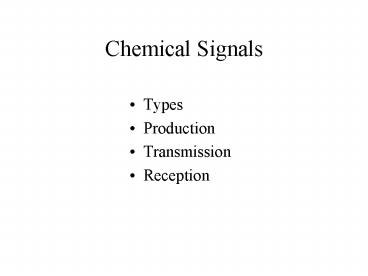Chemical Signals - PowerPoint PPT Presentation
Title:
Chemical Signals
Description:
Chemical Signals Types Production Transmission Reception Olfactory signal features Directionality Generally propagate away, but rarely linear Transmission speed ... – PowerPoint PPT presentation
Number of Views:121
Avg rating:3.0/5.0
Title: Chemical Signals
1
Chemical Signals
- Types
- Production
- Transmission
- Reception
2
Olfactory signal features
- Directionality
- Generally propagate away, but rarely linear
- Transmission speed
- Depends on diffusion rates, wind speeds
- Temporal pattern
- Difficult to turn on and off
- Spectrum
- Multi-dimensional
3
Chemical signals
- Hormone
- Chemical signals used within individuals
- Produced by endocrine glands
- Pheromone
- Chemical signals used between conspecifics
- Produced by exocrine glands
- Allomone
- Chemical signals used between species
4
Pheromone examples
Diffusion rate is inversely related to molecule
size. Small compounds are volatile. Large
compounds can persist
5
Odor glands in mammal skin
6
Vertebrate glands
7
Scent dissemination strategies
8
Female marking by greater spear-nosed bats
9
Multi-modal signalling in sac-winged bats
10
Scent glands in ants
11
Diffusion of a scent puff
K threshold of detection, rA active space, t
time
12
Active space is dynamic
There is a maximum size of active space which is
set by the detection threshold and amount of
odorant released
13
Media affects transmission
Q number of molecules released K detection
threshold D diffusion rate
14
Diffusion from a trail
Treat as if there are a series of single
emissions from a moving source
15
Diffusion in laminar flow
16
Diffusion in turbulent flow
17
Moth active space in wind
18
Insect odor receptor organs
19
Insect olfactory sensilla
20
Vertebrate odor receptor organs
Vomeronasal organ detects steroid hormones in
urine
21
Olfactory receptor cell
Olfactory receptor proteins have 7
trans-membrane domains, but belong to a gene
family with over 1000 loci. Receptor cells Are
short-lived (lt 60 d), and express a single
protein. creates odor-topic map in olfactory bulb
22
Gradient detection and orientation
- Simultaneous sampling
- Requires paired olfactory receptors at sides of
body. - Need wide head or nose on appendage (antenna)
- Sequential sampling
- Animals follow concentration gradient, requires
tracking back and forth across trail.
23
Moth scent tracking
Animals follow concentration gradient, requires
tracking back and forth across trail. Some have
paired olfactory receptors at sides of body.































